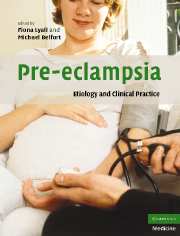Book contents
- Frontmatter
- Contents
- List of contributors
- Preface
- Part I Basic science
- 1 Trophoblast invasion in pre-eclampsia and other pregnancy disorders
- 2 Development of the utero-placental circulation: purported mechanisms for cytotrophoblast invasion in normal pregnancy and pre-eclampsia
- 3 In vitro models for studying pre-eclampsia
- 4 Endothelial factors
- 5 The renin–angiotensin system in pre-eclampsia
- 6 Immunological factors and placentation: implications for pre-eclampsia
- 7 Immunological factors and placentation: implications for pre-eclampsia
- 8 The role of oxidative stress in pre-eclampsia
- 9 Placental hypoxia, hyperoxia and ischemia–reperfusion injury in pre-eclampsia
- 10 Tenney–Parker changes and apoptotic versus necrotic shedding of trophoblast in normal pregnancy and pre-eclampsia
- 11 Dyslipidemia and pre-eclampsia
- 12 Pre-eclampsia a two-stage disorder: what is the linkage? Are there directed fetal/placental signals?
- 13 High altitude and pre-eclampsia
- 14 The use of mouse models to explore fetal–maternal interactions underlying pre-eclampsia
- 15 Prediction of pre-eclampsia
- 16 Long-term implications of pre-eclampsia for maternal health
- Part II Clinical Practice
- Subject index
- References
5 - The renin–angiotensin system in pre-eclampsia
from Part I - Basic science
Published online by Cambridge University Press: 03 September 2009
- Frontmatter
- Contents
- List of contributors
- Preface
- Part I Basic science
- 1 Trophoblast invasion in pre-eclampsia and other pregnancy disorders
- 2 Development of the utero-placental circulation: purported mechanisms for cytotrophoblast invasion in normal pregnancy and pre-eclampsia
- 3 In vitro models for studying pre-eclampsia
- 4 Endothelial factors
- 5 The renin–angiotensin system in pre-eclampsia
- 6 Immunological factors and placentation: implications for pre-eclampsia
- 7 Immunological factors and placentation: implications for pre-eclampsia
- 8 The role of oxidative stress in pre-eclampsia
- 9 Placental hypoxia, hyperoxia and ischemia–reperfusion injury in pre-eclampsia
- 10 Tenney–Parker changes and apoptotic versus necrotic shedding of trophoblast in normal pregnancy and pre-eclampsia
- 11 Dyslipidemia and pre-eclampsia
- 12 Pre-eclampsia a two-stage disorder: what is the linkage? Are there directed fetal/placental signals?
- 13 High altitude and pre-eclampsia
- 14 The use of mouse models to explore fetal–maternal interactions underlying pre-eclampsia
- 15 Prediction of pre-eclampsia
- 16 Long-term implications of pre-eclampsia for maternal health
- Part II Clinical Practice
- Subject index
- References
Summary
Angiotensin II (AngII) has suffered from being a hormone with a long history. Like an aging film star, it has tended to be overlooked. The renin–angiotensin system (RAS) was among the first hormone systems to be studied when Tigerstedt and Bergman described how intravenously injected saline extracts of kidney caused pronounced hypertension in rabbits (Tigerstedt and Bergman, 1898), and it is as a vasoconstrictor system that the RAS has largely been regarded ever since. This is, however, only one aspect of the chameleon-like RAS. AngII has autocrine and paracrine effects, as well as effects as a classic circulating hormone. Furthermore, fragments of angiotensin can have widely differing actions, and can work through receptors other than the well-described types 1 and 2. This chapter will consider the circulating RAS in pre-eclampsia as well as its effects as a paracrine system in relation to cell proliferation, differentiation and apoptosis, interaction with other cytokines, vascular media hypertrophy, endothelial dysfunction and atherothrombosis. Many of these have not yet been studied in relation to pre-eclampsia, but the parallels with non-pregnant hypertension suggest strongly that they should be.
Synthesis
The enzyme renin, an aspartyl protease, has only one substrate, the α2-globulin angiotensinogen (Aogen) (Poulsen and Jacobsen, 1993). The converse, however, is not true. Aogen acts as a substrate for a number of other enzymes, among them cathepsins D and G, tonin and tissue plasminogen activator (Dzau et al., 1988; Klickstein et al., 1982), all of which can cleave it, some apparently resulting in the direct synthesis of AngII without the intervening production of angiotensin I (AngI).
- Type
- Chapter
- Information
- Pre-eclampsiaEtiology and Clinical Practice, pp. 78 - 91Publisher: Cambridge University PressPrint publication year: 2007



